Charles Atherton Cumming
Charles Atherton Cumming | |
|---|---|
| Born | March 31, 1858 |
| Died | February 16, 1932 (aged 73) |
| Nationality | American |
| Education | |
| Known for | Artist, Educator, Author |
Charles Atherton Cumming (1858–1932) was an American Regionalist painter, a muralist, and educator.[1][2]
Early life
Cumming was born in Rochester, Illinois, to George Paxton Cumming, a farmer and schoolteacher from Tennessee who moved to Illinois and died in the American Civil War. His mother was Eliza Ellen Atherton.[3][4]
Career
Cumming was an important figure and deeply entrenched in the Iowa art scene of the first half of the 20th century.[5] He studied at the National Academy of Design, Chicago Art Institute. While there (1878-1879), he studied with Lawrence Carmichael Earle. Whilst at the Académie Julian he was a pupil of Gustave Boulanger and Jules Lefebvre and visited galleries in France and Luxembourg. He went to Paris again in 1889 and studied with Henri Lucien Doucet and Jean-Joseph Benjamin-Constant. During these European sojourns, he experienced a classical, academic training, and his encounters with European culture greatly influenced his artistry for the remainder of his life.
Cummings was a prominent figure in the development of the Department of Graphic and Plastic Arts at the University of Iowa and Cornell College.[3] Some of his teaching manuscripts form part of the Eve Drewelowe collection.[6]
He exhibited widely and was a popular portraitist.[7] He painted portraits of influential Iowan’s such as Phineas M. Casady, Robert Spencer Finkbine William Larrabee, Thomas Huston Macbride and S. H. M. Byers.[2][8][9]. He painted a posthumous portrait of Black Hawk (Sauk leader).[10]
In 1895 he founded the Cumming School of Art in Des Moines, Iowa,[11] which continued operating until 1954.[3][12] His works can be found in numerous public and private collections.[12]
Cumming launched the art department at Cornell College and, in 1909, had become the founding head of the art department at the University of Iowa (Iowa City), a position he continued to hold while also teaching in Des Moines.
Cumming was the author of "Classification of the Arts of Expression"; "The White Man's Art Defined," "The Psychology of the Symbolic Pictorial Arts"; "My Creed" and "Drawing a Neglected Factor in Education".[3][13]
Cumming's motto was, "Live and serve, here and now while reaching with one hand toward the ideals of the cultured past and with the other hand toward the hopes of the future."[14]
Cumming was part of the Capitol Improvements Committee which brought art into government buildings and created public murals, of which he created his own in 1912 for the Polk County Courthouse titled "Departure of the Indians from Fort Des Moines".
Iowa State University incorrectly refer to him as Cummings in lieu of Cumming.
Gallery
-
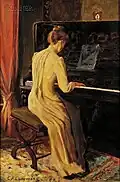 At the piano (1892)
At the piano (1892) -
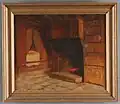 Brittany Kitchen in Hotel Grand Maison (date unknown)
Brittany Kitchen in Hotel Grand Maison (date unknown) -
 Misty Morning Spring Landscape (1894)
Misty Morning Spring Landscape (1894) -
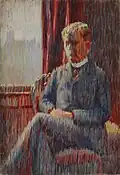 Impressionistic Portrait of Seated Man & verso
Impressionistic Portrait of Seated Man & verso -
 Mid-summer landscape (presumably Iowa)
Mid-summer landscape (presumably Iowa) -
 Brittany Girl
Brittany Girl -
 Girl in Red Dress - (circa 1890)
Girl in Red Dress - (circa 1890) -

-
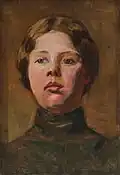
-
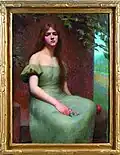 Neva (date unknown)
Neva (date unknown)
Exhibitions
- Charles Atherton Cumming: A Deep Root for Iowa Art - State Historical Building, March 1997[15]
Legacy
Velma Wallace Rayness collaborated on Charles Atherton Cumming: Iowa's Pioneer Artist-Educator in 1972, published by the Iowa Art Guild.[16][17] A number of his paintings are exhibited at the MacNider Art Museum.[18]
Personal
Cummings married an acclaimed artist, Alice McKee in 1926.[14] Between 1927 and 1932 he maintained a studio at 521 Palm St, San Diego, California.[14][19] He died in 1932 and is buried in Glendale Cemetery, Des Moines, Iowa.[2]
Ancestry
Cummings personal papers indicate that he was also interested in his own genealogy. On his maternal side he was the grandson of Milton Samuel Atherton (1813-1893), of Nevada, Missouri. He is an ancestor of Aaron Atherton (1742-1831).[3]
References
- ^ "Charles Atherton Cumming". AskArt. Retrieved July 19, 2025.
- ^ a b c "Charles A. Cumming, Director, Des Moines Academy of Art" (PDF). Pieces of Iowa's Past. January 20, 2021. Archived (PDF) from the original on January 20, 2021. Retrieved July 20, 2025.
- ^ a b c d e "Charles A. Cumming Papers RG 99.0029". Iowa University Library.
- ^ "George Paxton Cumming". Atherton One Name Study. Archived from the original on July 24, 2021. Retrieved July 20, 2025.
- ^ "Charles Atherton Cummings". Iowa State University Museum.
- ^ "Manuscripts on teaching drawing by Charles A. Cumming, November 22". 1926.
- ^ Leet, Richard. "Charles Atherton Cumming: A Deep Root for Iowa Art". Traditional Fine Arts Association. Archived from the original on March 15, 2025. Retrieved July 20, 2025.
- ^ "Samuel Hawkins Marshall Byers by Charles Atherton Cumming". Smithsonian.
- ^ "An Exhibition of Original Paintings by Charles A. Cumming (1858-1932) at the Armstrong Gallery, Cornell College, Mount Vernon, Iowa". Iowa Art Guild. 1972.
- ^ "Black Hawk". National Portrait Gallery, Smithsonian Institution.
- ^ Leet, Richard E. "Cumming, Charles Atherton". Biographical Dictionary of Iowa. Archived from the original on July 23, 2024. Retrieved July 20, 2025.
- ^ a b "Charles Atherton Cumming". The Annals of Iowa. 18 (7): 559. 1933. doi:10.17077/0003-4827.5631.
- ^ Rasmussen, Chris. "Agricultural Lag: The Iowa State Fair Art Salon,1854-1941" (PDF). pp. 12–20.
- ^ a b c "Iowa Artists of the First Hundred Years". Wallace-Homestead Company. 1939. pp. 56–57.
- ^ "Art Roots". The Des Moines Register, March 14. 1997. p. 33.
- ^ "Obituary for Velma Wallace Rayness". The Des Moines Register. April 15, 1977. p. 20. Retrieved July 24, 2025.
- ^ "Cumming's art legacy to Iowa on view, September 2". The Des Moines Register. 1984. p. 25.
- ^ "Museum Receives Painting". Iowa Globe-Gazette, December 14. 2000. p. 23.
- ^ "American Art Annual". MacMillan Company. 1931. p. 500.